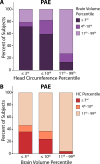Relationships between Head Circumference, Brain Volume and Cognition in Children with Prenatal Alcohol Exposure
- PMID: 26928125
- PMCID: PMC4771159
- DOI: 10.1371/journal.pone.0150370
Relationships between Head Circumference, Brain Volume and Cognition in Children with Prenatal Alcohol Exposure
Abstract
Head circumference is used together with other measures as a proxy for central nervous system damage in the diagnosis of fetal alcohol spectrum disorders, yet the relationship between head circumference and brain volume has not been investigated in this population. The objective of this study is to characterize the relationship between head circumference, brain volume and cognitive performance in a large sample of children with prenatal alcohol exposure (n = 144) and healthy controls (n = 145), aged 5-19 years. All participants underwent magnetic resonance imaging to yield brain volumes and head circumference, normalized to control for age and sex. Mean head circumference, brain volume, and cognitive scores were significantly reduced in the prenatal alcohol exposure group relative to controls, albeit with considerable overlap between groups. Males with prenatal alcohol exposure had reductions in all three measures, whereas females with prenatal alcohol exposure had reduced brain volumes and cognitive scores, but no difference in head circumference relative to controls. Microcephaly (defined here as head circumference ≤ 3rd percentile) occurred more often in prenatal alcohol exposed participants than controls, but 90% of the exposed sample had head circumferences above this clinical cutoff indicating that head circumference is not a sensitive marker of prenatal alcohol exposure. Normalized head circumference and brain volume were positively correlated in both groups, and subjects with very low head circumference typically had below-average brain volumes. Conversely, over half of the subjects with very low brain volumes had normal head circumferences, which may stem from differential effects of alcohol on the skeletal and nervous systems. There were no significant correlations between head circumference and any cognitive score. These findings confirm group-level reductions in head circumference and increased rates of microcephaly in children with prenatal alcohol exposure, but raise concerns about the predictive value of this metric at an individual-subject level.
Conflict of interest statement
Figures






References
-
- Bartholomeusz HH, Courchesne E, Karns CM. Relationship between head circumference and brain volume in healthy normal toddlers, children, and adults. Neuropediatrics. 2002;33(5):239–41. - PubMed
-
- Ivanovic DM, Leiva BP, Perez HT, Olivares MG, Diaz NS, Urrutia MSC, et al. Head size and intelligence, learning, nutritional status and brain development Head, IQ, learning, nutrition and brain. Neuropsychologia. 2004;42(8):1118–31. - PubMed
-
- O'Connell EJ, Feldt RH, Stickler GB. Head Circumference Mental Retardation and Growth Failure. Pediatrics. 1965;36(1):62–66. - PubMed
Publication types
MeSH terms
Grants and funding
LinkOut - more resources
Full Text Sources
Other Literature Sources
Medical

